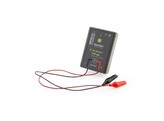The Go Direct Voltage Probe combines a wide input voltage range and high precision, making it an excellent choice for investigations of both AC/DC circuits and electromagnetism. It connects via Bluetooth® wireless technology or via USB to your device.
he Go Direct Voltage Probe combines a wide input voltage range and high precision, making it an excellent choice for lab investigations of both AC/DC circuits and electromagnetism. Use this differential probe to measure the voltage in simple circuits, to study basic principles of electrochemical cells.
With a range of 20 V, this system is ideal for use in “battery and bulb” circuits. Go Direct Voltage is capable of kHz sampling and mV resolution, so you can also use it to capture more difficult electric potentials, such as the electromagnetic field induced in a coil by a moving magnet. This single sensor can take the place of several voltmeters in your classroom.
The Go Direct Voltage Probe can be used in a variety of experiments:
Measure potential difference at various places in series and parallel circuits.
Investigate Ohm’s law in simple circuits.
Measure the voltage across a capacitor in RC and RLC circuits.
Explore Faraday’s law and induced EMFs in a coil of wire.
Rechargeable Battery—Ready When You Are
The robust rechargeable battery offers long battery life and provides always-ready operation when using the sensor wirelessly. Monitor battery life directly from our award-winning Vernier Graphical Analysis® app, as well as LabQuest® 3. Should the battery run low, simply connect the sensor to the charging cable and keep on collecting—no interruptions or inconvenience to you or your students.
Wireless or Wired—The Flexibility to Choose
Our Go Direct sensors connect directly to your mobile device, Chromebook™, or computer using our Vernier Graphical Analysis® app—no additional equipment or software purchases are necessary. Go Direct sensors can be used wired via USB or wirelessly via Bluetooth® wireless technology, allowing you to choose the best solution for your classroom or laboratory.
Specifications
Differential input voltage range: 20 V
Maximum voltage on any input: 24 V
Typical resolution: 5 mV on Potential – 20 V channel
Maximum sampling rate: 1,000 samples/s
Power: Internal rechargeable battery or USB connection
Connections:
Wireless: Bluetooth
Wired: USB
he Go Direct Voltage Probe combines a wide input voltage range and high precision, making it an excellent choice for lab investigations of both AC/DC circuits and electromagnetism. Use this differential probe to measure the voltage in simple circuits, to study basic principles of electrochemical cells.
With a range of 20 V, this system is ideal for use in “battery and bulb” circuits. Go Direct Voltage is capable of kHz sampling and mV resolution, so you can also use it to capture more difficult electric potentials, such as the electromagnetic field induced in a coil by a moving magnet. This single sensor can take the place of several voltmeters in your classroom.
The Go Direct Voltage Probe can be used in a variety of experiments:
Measure potential difference at various places in series and parallel circuits.
Investigate Ohm’s law in simple circuits.
Measure the voltage across a capacitor in RC and RLC circuits.
Explore Faraday’s law and induced EMFs in a coil of wire.
Rechargeable Battery—Ready When You Are
The robust rechargeable battery offers long battery life and provides always-ready operation when using the sensor wirelessly. Monitor battery life directly from our award-winning Vernier Graphical Analysis® app, as well as LabQuest® 3. Should the battery run low, simply connect the sensor to the charging cable and keep on collecting—no interruptions or inconvenience to you or your students.
Wireless or Wired—The Flexibility to Choose
Our Go Direct sensors connect directly to your mobile device, Chromebook™, or computer using our Vernier Graphical Analysis® app—no additional equipment or software purchases are necessary. Go Direct sensors can be used wired via USB or wirelessly via Bluetooth® wireless technology, allowing you to choose the best solution for your classroom or laboratory.
Specifications
Differential input voltage range: 20 V
Maximum voltage on any input: 24 V
Typical resolution: 5 mV on Potential – 20 V channel
Maximum sampling rate: 1,000 samples/s
Power: Internal rechargeable battery or USB connection
Connections:
Wireless: Bluetooth
Wired: USB
Properties
- 151102
- GDX-VOLT

